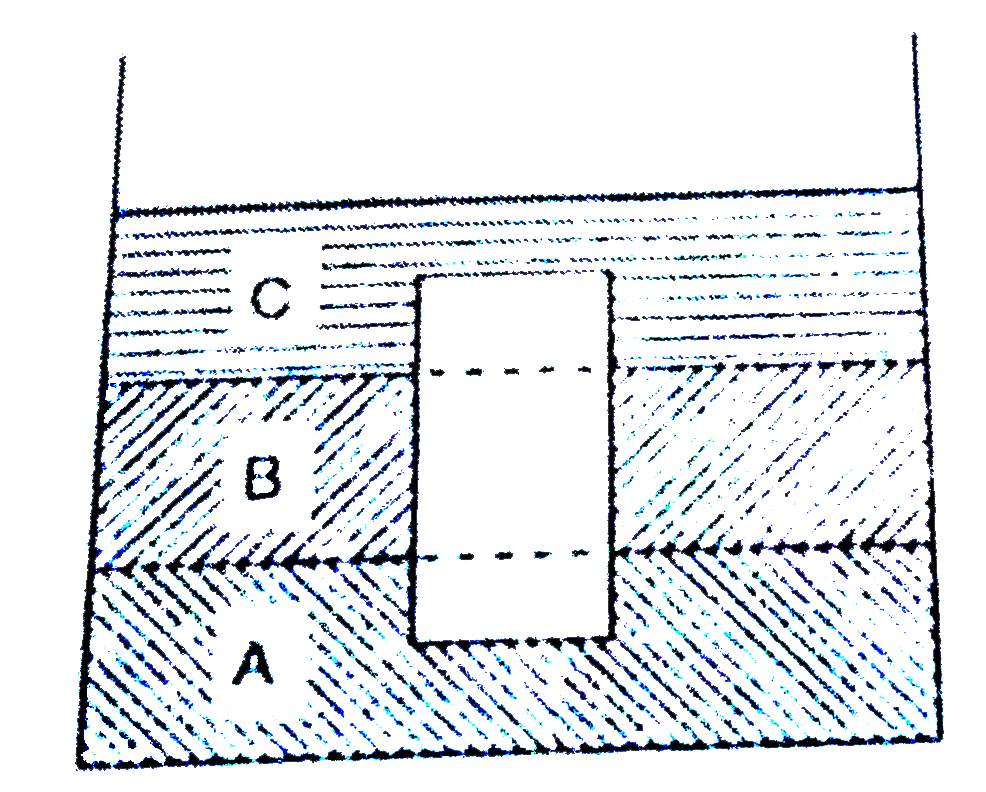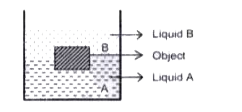An object floats in three immiscible liquids A, B and C of densities 3g cm−3,2g cm−3, respectively as shown in the figure. When the object is placed in the liquids, the levels of liquid A, B and C rise by 3 cm, 5 cm and 8 cm, respectively. The areas of cross-sections of the container and the object are 10 cm2and5cm2, respectively. Calculate the density of the object.

Weight of the floating body = Weight of the liquids A,B and C displaced.
Volume of the body immersed in a liquid = (Rise in level) × (area of cross-section of the container)
VA=(3cm)×(10cm2)
VA+VB=(5cm)×(10cm2)
VA+VB+VC=(8cm)×(10cm)= Total volume of the body
Weight of A displaced =VA×dA
Similarly, determine the weights of liquids B and C displaced.
Determine the density from the definition,
Density=massvolume
Topper's Solved these Questions
- HYDROSTATICEBOOK - PEARSON IIT JEE FOUNDATIONCHAPTER - HYDROSTATICEEXERCISE - LEVEL 2 UNDERSTANDING BASED QUESTION
6 Videos
- HYDROSTATICEBOOK - PEARSON IIT JEE FOUNDATIONCHAPTER - HYDROSTATICEEXERCISE - LEVEL 3
5 Videos
- HYDROSTATICEBOOK - PEARSON IIT JEE FOUNDATIONCHAPTER - HYDROSTATICEEXERCISE - LEVEL 1 MULTIPLE CHOICE QUESTIONS
29 Videos
- HEATBOOK - PEARSON IIT JEE FOUNDATIONCHAPTER - HEATEXERCISE - All Questions
115 Videos
- LIGHTBOOK - PEARSON IIT JEE FOUNDATIONCHAPTER - LIGHTEXERCISE - Level 3
10 Videos
Similar Questions
The volumes of three objects A,B and C are 100 cm3,200cm3 and 300cm3 respectively. If their masses are same which one will have greater density?
View SolutionAn object is made to float in two immiscible liquids as shown in figure. Compare the densities of two liquids A and B and the object.

View Solution
Knowledge Check
The focal length of objective and eye lens of a microscope are 4cm and 8cm respectively. If the least distance of distinct vision is 24cm and object distance is 4.5cm from the objective lens, then the magnifying power of the microscope will be
A18B32C64D20Three immiscible transparent liquids with refractive indices 3/2,4/3 and 6/5 are arranged one on top of another. The depth of the liquid are 3cm,4cm and 6cm respectively. The apparent depth of the vessel is
A10cmB9cmC8cmD7cm
The focal length of objective and eye lens of a microscope are 4 cm and 8 cm respectively. If the least distance of distinct vision is 24 cm and object distance is 4.5 cm from the objective lens, then the magnifying power of the microscope will be
View SolutionThe focal length of objective and eye lens of a microscope are 4cm and 8cm respectively. If the least distance of distinct vision is 24cm and object distance is 4.5cm from the objective lens, then the magnifying power of the microscope will be
View SolutionTwo immiscible of densities 2.5g/cm3 and 0.8g/cm3 are taken in the ratio of their masses as 2:3 respectively find the average density of the liquid conbination.
View SolutionTwo immiscible of densities 2.5g/cm3 and 0.8g/cm3 are taken in the ratio of their masses as 2:3 respectively find the average density of the liquid conbination.
View SolutionA container is filled with two immiscible liquids A and B of densities 2 g cm−3and3 g cm−3 , respectively. A wooden cube of side 1 cm floats on the surface of liquid A such that one-fourth of its total length is immersed in this liquid (A).
Now, the wooden cube is completely immersed in liquid A by suspending a sinker of volume 10 cm3 which is completely submerged in liquid B. Determine the weight of the sinker.
View SolutionThree immiscibles transparent liquids with erefractive indices 3/2,4/3 and 6/5 are arranged one on top of another. The depth of the liquid are 3 cm, 4 cm and 6 cm respectively. The apparent depth of the vessel is
View Solution
